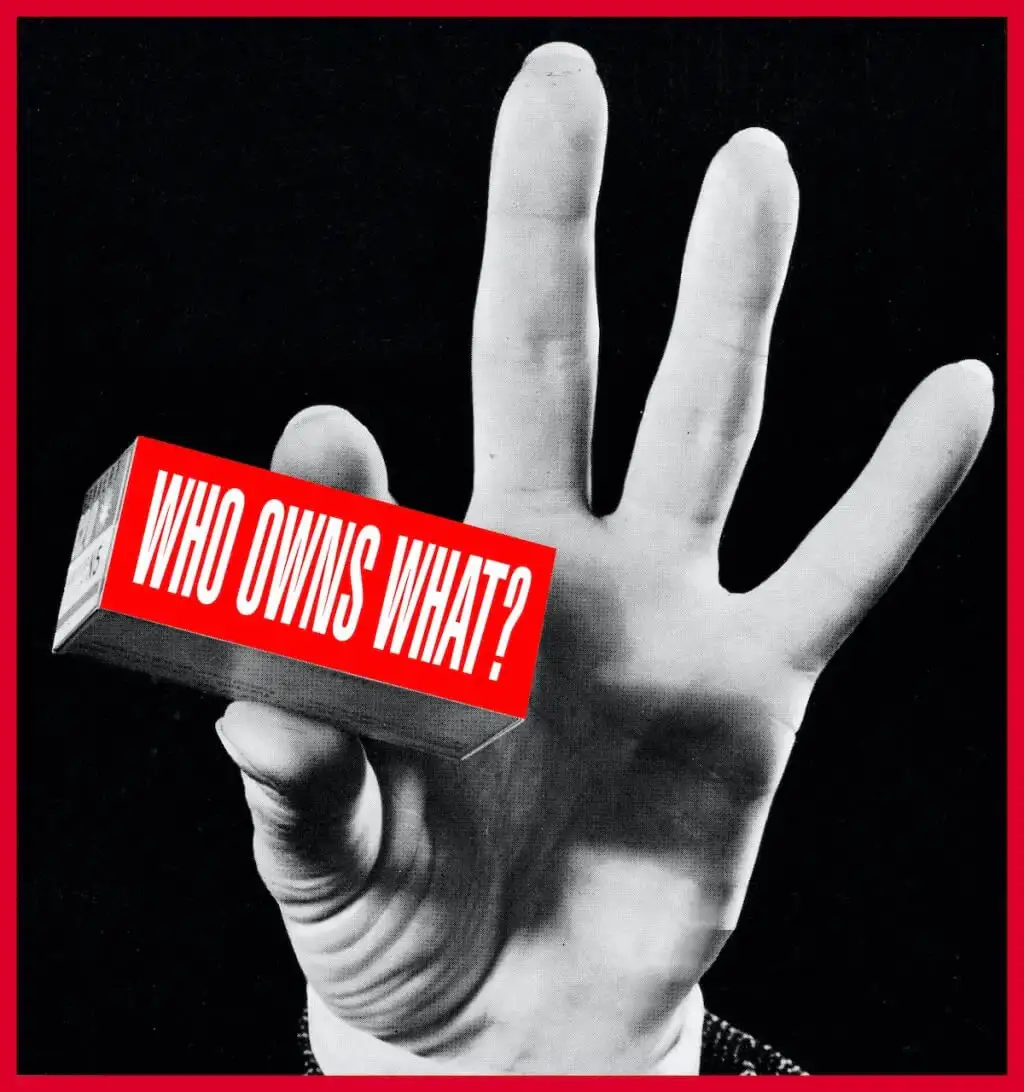
Untitled (Who owns what?), 1991/2012 by Barbara Kruger
Courtesy, Barbara Kruger and Sprüth Magers
Born in 1945 in Newark, New Jersey, the artist’s formative years coincided with America’s Golden Age of Advertising, commonly dated to the 1950s and 1960s. The combination of cultural changes, technological advancements – such as the rise of television, which unlocked new methods of storytelling – and economic growth resulted in a shift from the industry’s focus on research and science to one on emotion and creativity, a shift that proved highly successful. The power of visual and textual tools in an increasingly capitalist mindset was becoming acutely apparent, as more alarming currents lurk beneath bright, novel, and exciting slogans.
At the age of 22, Kruger, who attended Syracuse University and then Parsons School of Design in New York City, was promoted to head designer at Condé Nast Publications for Mademoiselle magazine. Her experience in graphic design in the heart of the growing marketing industry was, as she describes, the greatest influence on her artistic development. By the early 1970s, Kruger began showing work in New York’s galleries, initially working in painting and weaving. However, in 1976, she quit making art altogether, sensing a lack of meaning in her work. The year 1977 marked Kruger’s return to art-making, and shortly after, in 1979, she developed the visual language that would bring her global acclaim, making her one of the most influential living artists today.
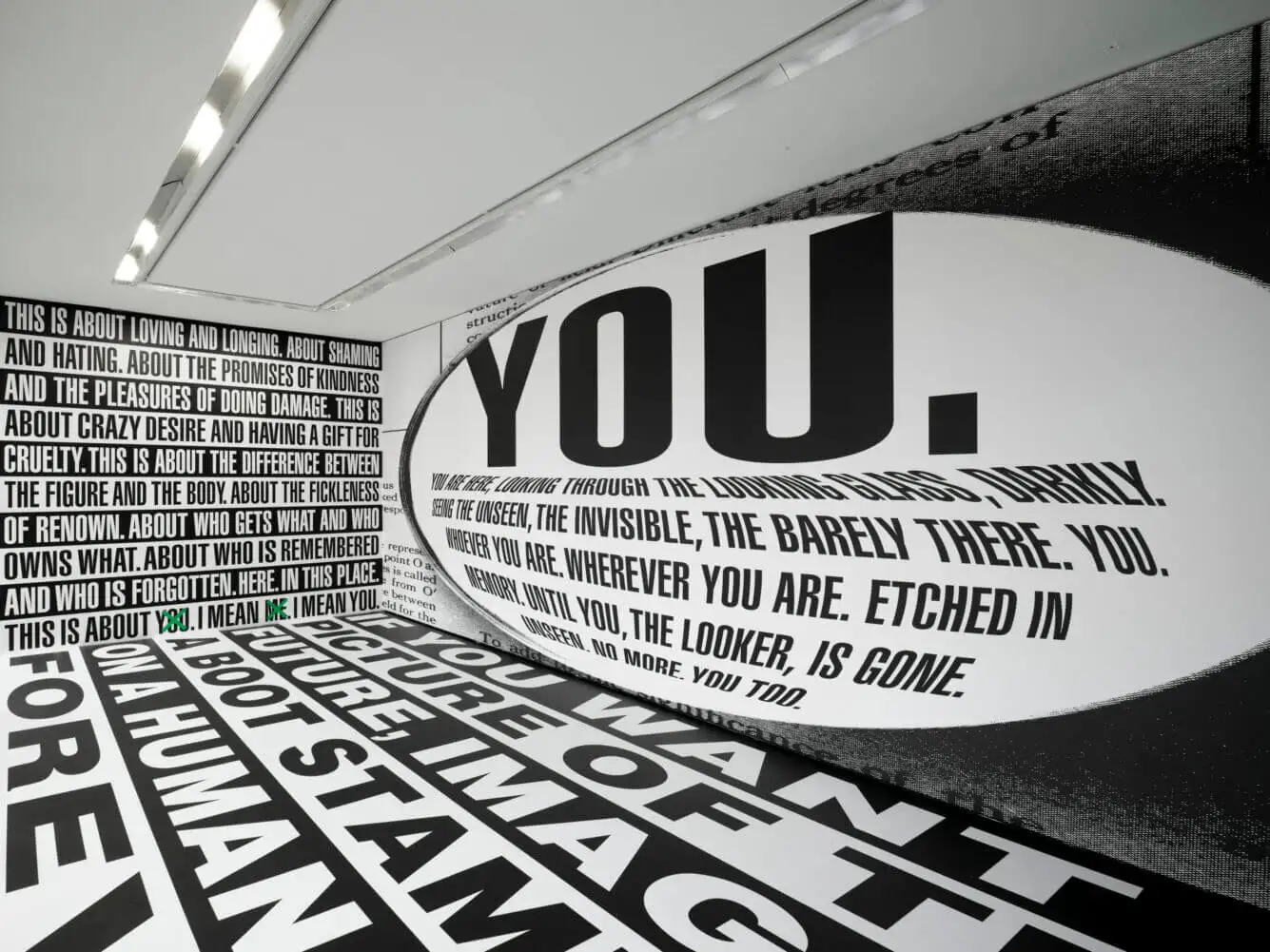
Barbara Kruger: Thinking of You. I Mean Me. I Mean You (Installation view, 1 February – 17 March 2024, at Serpentine South)
Photo: George Darrell
Kruger’s signature works are characterised by large-scale black-and-white photographic imagery overlaid with text set against the blocks of vivid red colour. To create these works, Kruger repurposes found imagery primarily from mid-century American print-media sources and employs graphic design strategies and advertising visual language, such as Futura Bold Oblique and Helvetica Ultra Compressed typesets. Alongside the photo-collages that are rendered on silk-screen, paper, walls, and public spaces, Kruger works in sculpture, video, sound and large-scale architectural installations.
Through the appropriation of the sensational and direct tone of advertising, Kruger constructs impactful critiques of the power structures inherent in mass media modes of communication, symptomatic of societal paradigms in the contemporary consumer-driven climate. Questions around gender, consumerism, race, power and control are at the core of the artist’s boldly articulated critique. To borrow the artist’s words, Kruger creates ‘to question and change the systems that contain us.’
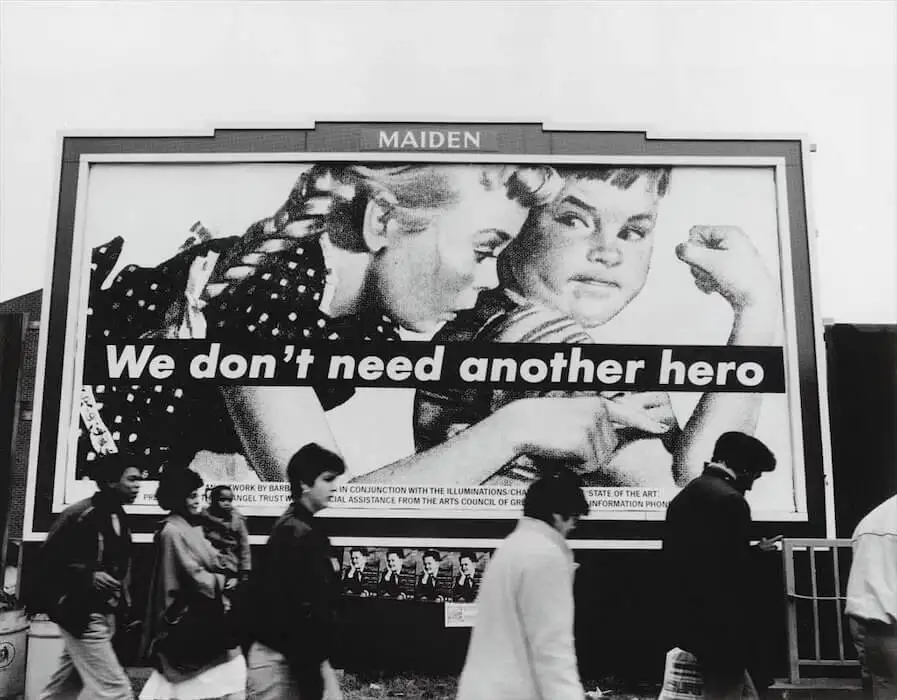
Untitled (We Don't Need Another Hero), 1986 by Barbara Kruger
Installation view of Billboard project, Artangle, London
Often involving personal pronouns, such as ‘I’, ‘You’, and ‘We’, Kruger’s work becomes confrontational not only to the structural and societal imbalances but also to the viewer. ‘Direct address has motored my work from the very beginning,’ Kruger says, ‘I like it because it cuts through the grease.’ Uncovering how messages in mainstream media shape our personal and public identities, Kruger demands the criticality of ‘knowing better’. The compelling and polished visual language of advertising is never without an inherent, appeasing demand: whether to consume, to tailor one’s perception of self, to follow a predetermined path, or to fit into carefully prepackaged societal expectations.
Over the years, the artist has shown her work across various contexts, including on buildings, buses, billboards, skate parks, and objects, such as mugs, magnets, T-shirts and shopping bags: the very products in the very market Kruger confronts. The artist is not seeking to transcend the marketplace; her work is a commentary that exists within it, grounded not so much in condemnation as in observation. As the viewer becomes complicit in her work through its direct address and is forced to form an opinion on a given issue, the polemic power of art quickly becomes apparent.
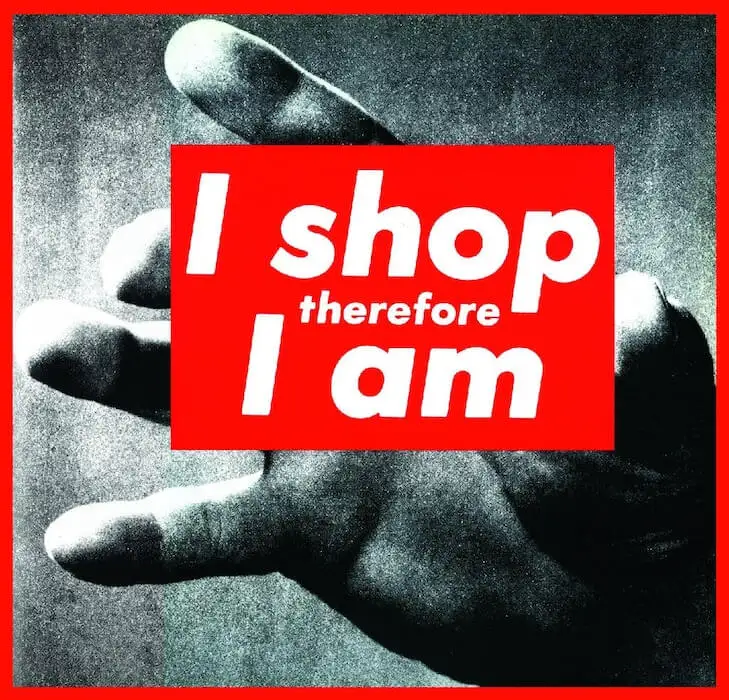
Barbara Kruger, Untitled (I shop therefore I am), 1987 © Barbara Kruger
Courtesy, Mar Boone Gallery NY
The familiar cultural signifiers – e.g. Descartes’ ‘I think, therefore I am’ turns into Untitled (I shop therefore I am) (1987) – are reappropriated in Kruger’s practice in a self-aware light. Speaking in the same language as that which she critiques, Kruger gains the upper hand. As she denounces consumerism in her commissions in shopping centres and calls into question the institutional authority of the museums that exhibit her work, the impact of the irony embedded in contradictions permeates her artistic language. At the same time, her use of found imagery shows that ‘seeing is no longer believing’: truth becomes a construct, susceptible to change depending on the light it is shown in. Accordingly, in the world of appearances, even the slightest distortions prove capable of shattering the illusion of wholeness altogether.
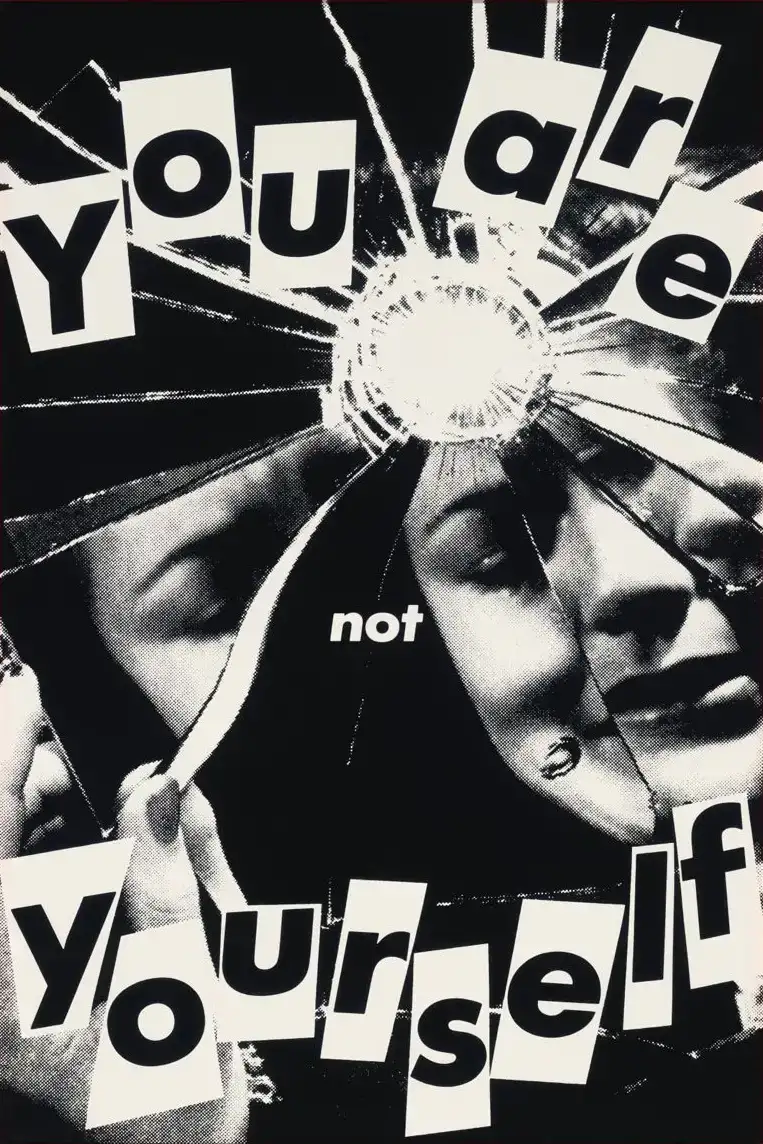
Untitled (You Are Not Yourself), 1983 by Barbara Kruger, Lyra Collection
Courtesy, Lyra Collection
As the mirror breaks, the image and the person it holds break into pieces, as in Untitled (You Are Not Yourself) (1983), which LYRA is proud to hold in its collection. The fragmentation of self here warns against the fragmentation of societal roles and expectations. As Kruger links contemporary modes of consumption with feminist critique, she reveals the way women are depicted in society – as objects of desire, there to be controlled, to be told what to do and what to want. The notion of self becomes complicated as one traces the external forces at play that shape it.
Crucially, to talk about language and imagery that represent our society is to talk about who has the voice to speak, and whose gaze dictates what is seen. Painstakingly depicting the way the male gaze is complicit in the objectification of women, Kruger manipulates Euro-American social norms that perpetuate gender inequality and turns the patriarchy on its head.
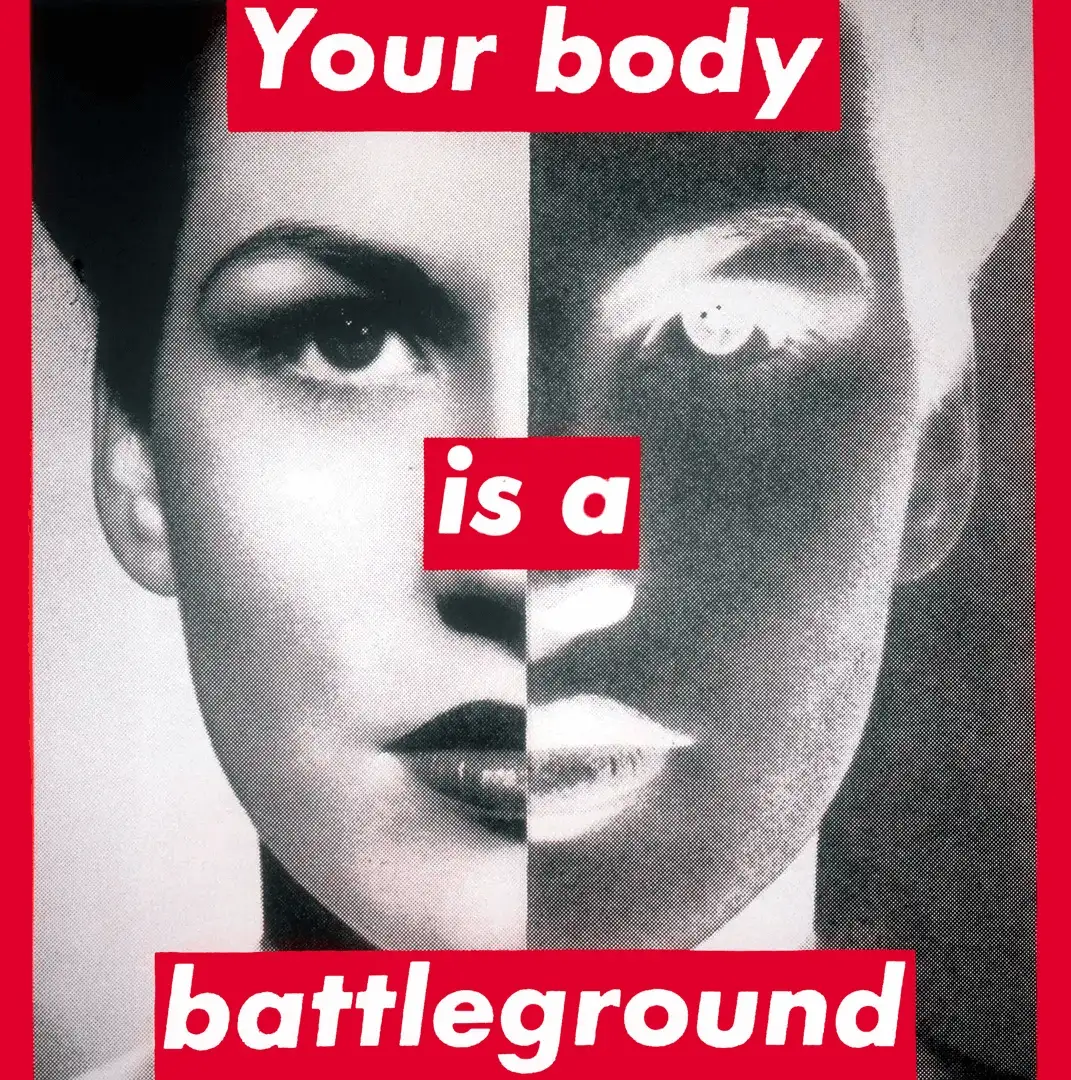
Untitled (Your Body Is A Battleground), 1989 by Barbara Kruger © Barbara Kruger
Courtesy, the Broad, Los Angeles
Untitled (Your Body is a Battleground) (1989) is a canonical work that is emblematic of Kruger’s activist stance. The image was initially proposed as a flier graphic to be used during the Women’s March on Washington on 9 April 1989, and was disseminated in the streets of New York on the day it took place in Washington. In the wave of lawsuits that threatened the federal right to abortion, granted by Roe v. Wade in 1973 and overturned in 2022, the March called for reproductive freedom. The female body was, and still is, the battleground for political ideologies and control, a truth that Kruger straightforwardly articulates.
Today, as access to abortion is no longer a federally protected right in the US, the words of Your Body is a Battleground, over the split image of the woman’s face, remain as relevant as they did when the work was first created. When Roe v. Wade was overturned, Kruger recreated the work, this time asking: ‘Who Becomes a “Murderer” in Post-Roe America?’. While the graphic, made for The New York Times Opinion section, read: ‘If the end of Roe has come as a shock to anyone, that means they haven’t been paying attention’.
Paying attention remains key in LYRA Collection’s dedication to the voices that challenge the status quo, whether societal, political, historical or art-historical. Providing space and a platform for artists who confront and challenge prejudice and injustice is LYRA’s honour and also a responsibility. We ask: instead of passively watching history unfold, how can we actively shape new, fiercer, more inclusive ways of being together in the world? What does it take to unlearn the dominant gaze and truly see differently? How do we reclaim control over the words and images designed to define our roles, our paths, our expectations? LYRA artists demonstrate that asking the right questions is the first step towards change, one that is in itself disruptive enough to destabilise even the most entrenched norms.
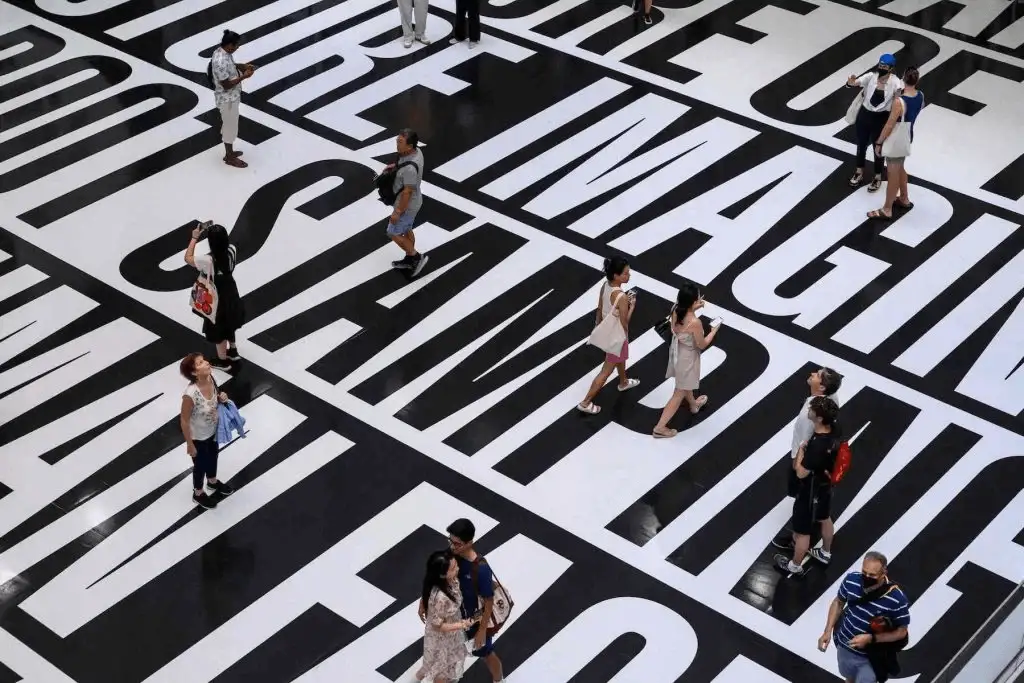
Thinking of You. I Mean Me. I Mean You, 2022 by Barbara Kruger. Installation view at The Museum of Modern Art in New York on 3 August 2022
Photo by Angela Weiss/AFP via Getty Images
As Kruger continues to confront us with the despairing reality in which we exist, we continue to shape our meaning. The artist’s practice remains the primary source that documents and critiques social constructs, uncovering ulterior motives within them. If language gives an authority its power and a belief its grounding, Kruger offers us a vernacular vocabulary to disrupt hegemonies embedded in our consumer-driven society. Still, the responsibility of what meaning we make and its impact on evolving societal patterns rests with us. To conclude, we resort to her words: ‘I think that art is still a site for resistance and for the telling of various stories, for validating certain subjectivities we normally overlook. I'm trying to be affective, to suggest changes, and to resist what I feel are the tyrannies of social life on a certain level.’